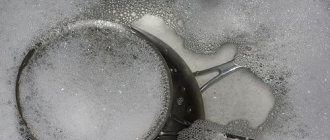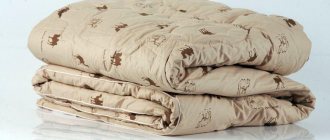Everyone knows that wool is a delicate fabric and needs special care. You can wash woolen items only in cool water, otherwise they will deteriorate - they will stretch or shrink. In addition, it is important to dry them in a special way and use special detergents. If you follow all the rules, the products will last a long time and look like new.
Features of wool fabrics
It's good to start with the fact that wool comes in different types. These are cashmere, angora, merino, sheepskin, mohair, etc. Each fabric has its own requirements for washing and care in general. They have only one thing in common – natural structure. Wool, like hair, is covered with keratinized scales. Under the influence of water, temperature, and chemicals, these scales open and the villi become especially vulnerable. They easily compact and interlock with each other, like hooks. As a result, the woolen item may be severely deformed and it will be impossible to restore it.
The whimsicality of wool depends on its variety, the method of dressing, the presence of synthetic impurities, and the cut of the finished item. To increase wear resistance, flakes on woolen threads are often burned with hypochlorous acid and then treated with a special compound (sizing agent). Because of this, woolen fabrics acquire shine and stop shrinking when washed, but fully retain their heat-saving properties.
Some tips
It is not enough to wash and dry wool properly. These products require more careful care:
- Do not hang woolen items on hangers - they will stretch and become ugly. Place wool in piles: bulky and heavy items down, lighter items up.
- Store items in closets along with moth repellents. For example, sachets with aromatic herbs or bars of soap repel pests.
- If the product can be ironed, use the “wool” mode.
- Several times a year, woolen clothes should be taken out into the sun, aired and shaken. This will help avoid dampness and unpleasant odors.
That's all you need to know about washing and caring for wool. Take care of your woolen products and attract admiring glances.
How to wash wool - 5 general rules
As already mentioned, wool comes in different varieties. Therefore, when washing, it is correct to be guided by the information on the label of a particular item. Some products cannot be washed at all, and the only thing the manufacturer allows is dry cleaning (of course, not at home).
If for some reason there is no label with washing recommendations on a woolen item, you should follow the general rules:
- The wool is soaked for a maximum of half an hour.
- Use warm water for washing.
- Detergents are liquid (powdered ones must first be dissolved).
- Several rinses, in plenty of warm water.
- Woolen items are only lightly wrung out without twisting or the water is allowed to drain.
At what temperature should I wash wool?
In hot water, wool loses its strength and slowly disintegrates into fibers. Therefore, woolen products should be washed at a temperature of 30-38 degrees. This is quite enough for light stains to soften and easily come off the item. If washing is needed for refreshment, you can not heat the water at all, but use cold or room temperature water right away.
Wool is not afraid of cold water, unless it stays in it for a long time. So, when exposed 20 times for 24 hours, its slight hydrolysis (decomposition) begins. But in general, low temperatures can only be harmful if there are sudden changes. For example, if you washed a woolen sweater in hot water and rinsed it in cold water, then the product would shrink.
How to wash woolen items?
Regular washing powders are harmful to wool. They contain a lot of alkali, which can dissolve natural fiber without leaving any residue. If you leave a woolen item in a 5% solution of caustic soda, not a trace will remain of it. The fact is that wool is of animal origin and consists of 75-85% keratin protein. Alkali is designed to dissolve protein contaminants, so it spoils animal fibers. But at the same time, wool fabric is resistant to acids.
In industry, to remove plant debris (burdock, etc.) from wool, it is washed in a 5% solution of sulfuric acid. And to clean natural fabrics from cotton, linen and other plants from protein impurities, use a 5% solution of caustic soda.
A separate line of detergents is produced for washing wool products at home. They have the following notes:
- "phosphate-free"
- "for delicate things"
- "for products made of wool and silk."
We recommend: Does the machine break if you wash it often and one item at a time?
Special gels and powders are available from Perwoll, Royal Powder, Laska, Sonett, Frosch and others. As for folk remedies for washing wool, experienced housewives advise using:
- shampoo;
- liquid soap with the addition of 1 tbsp. l. borax (for 5-7 kg of woolen items);
- grated laundry soap;
- mustard powder (30 g per 2 liters of water).
To prevent the wool from pricking and matting, it is recommended to additionally use conditioner and rinse aid when washing. The purchased product can be replaced with a homemade composition. To do this, hair balm, vinegar and water are mixed in a ratio of 2:3:6. For 5 liters of water the consumption is approximately 120 ml. Alternative recipe: for 5 liters of water you need to take 5 tbsp. spoons of vinegar and 1 tbsp. a spoonful of glycerin.
Washing frequency
Wool does not like water and chemicals, so it is advisable to wash products made from it as rarely as possible. If the item is not critically dirty, it is recommended to use alternative cleaning methods:
- Unpleasant odor can be easily removed from wool by airing for 24-48 hours.
- Stains from food, drinks, and lipstick are wiped off with a damp cloth or alcohol solution.
- Greasy areas are cleaned with ammonia and a soft brush.
- Oil stains and paint marks are removed with turpentine or gasoline.
- To remove coffee, tea, and milk from wool, you can use glycerin slightly heated in a water bath.
Handwash
Hand washing wool products is preferable to machine washing, especially for clothes made of delicate wool: angora, mohair, alpaca.
Wool absorbs moisture, so pour plenty of water into the basin to ensure the item stretches well. The water is warm, but not warmer than 35 degrees. The temperature should not change during the washing process - replace it with a fresh one more often.
Use soft water, preferably filtered. If there is no flow or volumetric filter, soften or acidify the water with vinegar. This will help make the fabric soft and less scratchy, and avoid loss of color of the shedding product. The amount of substance per 10 liters of water is 3 tablespoons.
Choose gentle laundry detergents. Special gels for wool are preferred; they dissolve well in water. Regular shampoo is suitable for washing your hair; it is not as aggressive as powder. Pour a small amount of detergent into a basin and immerse the prepared product. How to properly wash woolen items? There is no need to actively rub or twist them: it is so easy to damage the fabric structure. Simply immerse the item and gently rinse it in the solution.
Washing wool by hand: step-by-step instructions
Washing wool items by hand is the best option. This requires more time and effort, but eliminates the risk of damage to the product. All you need to do is follow simple instructions:
- Fasten the product with all the buttons (lock) and turn it inside out.
- Pour warm water into a large basin and control the temperature (30-35 degrees).
- Add detergent to the water according to the instructions on the package and stir thoroughly until foam appears.
- Lower the woolen item and leave it in the basin for 5-30 minutes.
- Rub the stained areas with stroking movements (you can use a soft brush).
- Rinse the product in plenty of warm water, draining it at least 3 times.
If the label on an item is cut off and you are not sure that it is made of wool, you can check it as follows. From the inside you need to find the free end of the woolen thread that is used to cover the edge of the product (you will need very little, 3-4 mm). Next, you need to carefully cut it off without damaging the integrity of the product itself, and set it on fire with a lighter. The smell of a burnt feather will indicate that the thread is wool. Moreover, if it is 100% natural, it will burn without a residue and turn into black ash, and if it is mixed with synthetics, it will leave a hard, charred head.
Folk remedies
Mustard powder is used to wash dark clothes. 1 glass of dry matter is dissolved in a small amount of water, filtered and allowed to brew, then added to a basin and washed. An alternative to industrial air conditioners is ammonia. 1 teaspoon of the substance will soften the fabric.
Washing white wool items is a separate issue. When machine washing, bleach may be added. Hydrogen peroxide refreshes yellowed clothes: 1 tablespoon of peroxide per 1 liter of water. Soak the clothes briefly in this solution, then wash and rinse well.
Another effective folk method is crushed chalk. You will need 1 kg per 3 liters of water. Soak the yellowed wool item in the solution, then wash it. The canvas will bleach.
Instructions for washing woolen items in the washing machine
Automatic washing is acceptable if the product contains a certain percentage of synthetics or is treated with a special composition. You need to look for the relevant information on the label. If the manufacturer allows it, you can safely get down to business.
We recommend: A collection of useful tips for washing underwear: from soaking to spinning
How to wash woolen items in a washing machine?
- Prepare items for washing: inspect for damage, fasten and turn inside out.
- Pour detergent into the powder compartment, and conditioner into a small container with a star (flower).
- Select the "Wool" program.
- Wait until the wash is finished.
If there is no special program in the machine, you can use “Hand Wash”, “Delicate Wash” or set the appropriate parameters yourself:
- temperature – 30 degrees;
- washing time – 30 minutes;
- remove spin;
- add rinse.
Washing dark and light items
The question of how to wash wool of dark colors deserves special attention. Experienced housewives recommend the method using mustard.
- Dilute mustard powder with water.
- Strain the mixture, add water and leave to infuse.
- Wash the product in the resulting solution, without using detergents, and then rinse thoroughly.
Pay close attention to light wool. Before washing, soak yellowed white items in water with previously added hydrogen peroxide.
How to dry woolen items?
Drying woolen products is a process no less important than washing. To prevent things from becoming deformed, they should not be hung on clothespins or ropes. Wool is dried only horizontally (with the exception of coats and jackets). How to do it right?
- Place the wet item horizontally on a terry towel, straighten it and let the moisture drain. A woolen sweater, blanket or other simple-shaped item (except a beret) can be covered with a second towel, rolled into a roller and lightly squeezed.
- If you have a drying cabinet at home, set the temperature to 100-105°.
- If there is no drying, place things in a well-ventilated room on moisture-absorbing material (towel, sheet). Make sure they lie flat, seam to seam.
- Be patient. The wool needs to dry for about a day. Periodically, the fabric underneath needs to be changed and the product itself needs to be turned over.
Woolen items will dry faster if the air conditioner or heater is on in the room. There is no need to direct them or bring them closer to the product. It is enough to make the air warm and dry.
Wool shrinkage
All of the above recommendations help maintain the original appearance of the product. But sometimes you need to wash an item - for example, a wool sweater - so that it shrinks. For this, the following technology is used:
- Dip the sweater in soapy water heated to 50-60 degrees for 10 minutes.
- Wash it as usual.
- Rinse in cool water (15-20 degrees).
It is important not to allow too sudden temperature changes, otherwise the shrinkage will exceed all expectations. A woolen jacket can shrink by 3-4 sizes and turn from excessively large to small. In addition, you should remember to be careful when spinning and drying. In hot water, the pile fluffs up and becomes especially easily deformed.
Woolen items require careful handling and additional energy consumption for washing. But they reliably retain the body heat of their owner and look beautiful. Therefore, it is worth trying to remember simple rules for caring for hair. It's not difficult - there are only 5 most important points!











